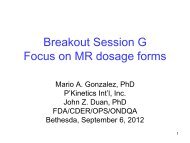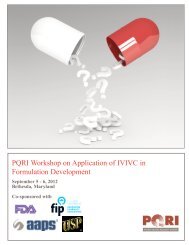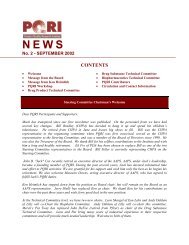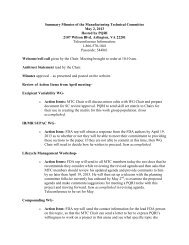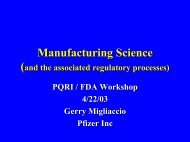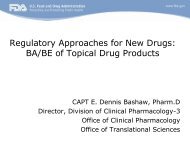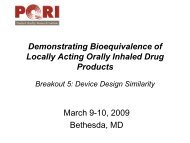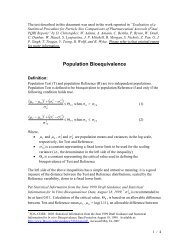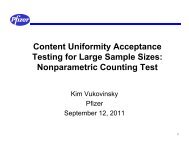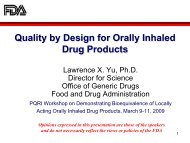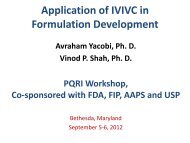EMA Guidance on MR Dosage Form - PQRI
EMA Guidance on MR Dosage Form - PQRI
EMA Guidance on MR Dosage Form - PQRI
Create successful ePaper yourself
Turn your PDF publications into a flip-book with our unique Google optimized e-Paper software.
Safeguarding public health<br />
European <str<strong>on</strong>g>Guidance</str<strong>on</strong>g> <strong>on</strong> Modified<br />
Release <strong>Dosage</strong> <strong>Form</strong>s<br />
Terry Shepard,<br />
Pharmacokinetics Assessor<br />
Medicines and Healthcare products Regulatory Agency<br />
L<strong>on</strong>d<strong>on</strong><br />
<strong>PQRI</strong> Workshop <strong>on</strong> Applicati<strong>on</strong> of IVIVC in <strong>Form</strong>ulati<strong>on</strong><br />
Development<br />
September 5 - 6, 2012<br />
Bethesda, Maryland<br />
©
Disclaimer<br />
The views expressed during this<br />
presentati<strong>on</strong> are those of the<br />
speaker and do not necessarily<br />
represent the views of the MHRA<br />
or the <str<strong>on</strong>g>EMA</str<strong>on</strong>g>/CHMP.<br />
Slide 2<br />
©
Outline<br />
European Regulatory System<br />
Status of European <str<strong>on</strong>g>Guidance</str<strong>on</strong>g> <strong>on</strong> <strong>MR</strong> Products<br />
MHRA Experience<br />
Key Messages and Opportunities<br />
Slide 3<br />
©
European Regulatory System<br />
CHMP<br />
Assessors in Nati<strong>on</strong>al Agencies<br />
Nati<strong>on</strong>al MAs,<br />
Nati<strong>on</strong>al Scientific<br />
Advice<br />
<str<strong>on</strong>g>EMA</str<strong>on</strong>g> … …<br />
Working Parties<br />
e.g. Scientific<br />
Advice/Guidelines<br />
MA: marketing authorisati<strong>on</strong><br />
Slide 4<br />
©
European <str<strong>on</strong>g>Guidance</str<strong>on</strong>g> <strong>on</strong> <strong>MR</strong> Products<br />
(currently in revisi<strong>on</strong>)<br />
www.ema.europa.eu<br />
Slide 5<br />
©
European <str<strong>on</strong>g>Guidance</str<strong>on</strong>g> relating to IVIVC<br />
(currently in revisi<strong>on</strong>)<br />
IVIVC Topic Covered<br />
Quality<br />
Secti<strong>on</strong><br />
Clinical<br />
Secti<strong>on</strong><br />
Levels of IVIVC: definiti<strong>on</strong>s <br />
Levels of IVIVC: advantages, disadvantages of different levels <br />
Role of IVIVC<br />
• establishing discriminatory power of in vitro dissoluti<strong>on</strong> test (Quality)<br />
• clinical relevance of in vitro dissoluti<strong>on</strong> tests and associated dissoluti<strong>on</strong><br />
specificati<strong>on</strong>s (PK and Clinical)<br />
<br />
<br />
Programme rati<strong>on</strong>ale: choice of formulati<strong>on</strong>s for IVIVC study X-ref<br />
Programme rati<strong>on</strong>ale: choice of reference formulati<strong>on</strong> <br />
Programme rati<strong>on</strong>ale: extending IVIVC bey<strong>on</strong>d IVIVC batches <br />
Slide 6<br />
©
European <str<strong>on</strong>g>Guidance</str<strong>on</strong>g> relating to IVIVC<br />
(currently in revisi<strong>on</strong>)<br />
IVIVC Topic Covered<br />
Quality<br />
Secti<strong>on</strong><br />
Clinical<br />
Secti<strong>on</strong><br />
Study design: in vitro study design (dissoluti<strong>on</strong> media, sampling times) -<br />
Study design: in vivo study design (number of subjects, sampling times) - <br />
IVIVC data analysis: acceptable methodology for model development X-ref <br />
IVIVC validati<strong>on</strong>: assessment of predictability X-ref <br />
IVIVC development and validati<strong>on</strong>: reporting - <br />
Applicati<strong>on</strong>s: specificati<strong>on</strong> setting -<br />
Applicati<strong>on</strong>s: waiver of BE studies for product variati<strong>on</strong>s -<br />
Slide 7<br />
©
Why do companies develop IVIVCs<br />
in vitro dissoluti<strong>on</strong> = surrogate for BE study<br />
save time and m<strong>on</strong>ey<br />
Why do regulators encourage IVIVCs<br />
Approval Process<br />
Post-approval<br />
Benefit<br />
Risk<br />
Reassurance that<br />
positive benefit/risk<br />
balance is maintained<br />
throughout life of product<br />
Approval<br />
CHMP Opini<strong>on</strong> + Annexes (SmPC, C<strong>on</strong>diti<strong>on</strong>s)<br />
Refusal or<br />
Withdrawal<br />
Slide 8<br />
©
Examples of <strong>MR</strong> Product Variati<strong>on</strong>s:<br />
Methods<br />
Search of Sentinel database<br />
“granted licenses prol<strong>on</strong>ged release formulati<strong>on</strong>s”<br />
385 licenses/69 companies<br />
“Type II variati<strong>on</strong>s - pharmaceutical”<br />
63 licenses of interest<br />
Compiled all variati<strong>on</strong>s for 63 licenses<br />
3 representative examples +<br />
additi<strong>on</strong>al points from 4-5 others<br />
Slide 9<br />
©
<strong>MR</strong> Product Variati<strong>on</strong>s: Example 1<br />
23 variati<strong>on</strong>s<br />
II<br />
1b<br />
1a<br />
5 pharmaceutical variati<strong>on</strong>s<br />
6<br />
5<br />
4<br />
3<br />
2<br />
MA: 2001 1<br />
Label/Leaflet<br />
9<br />
8<br />
7<br />
10<br />
11<br />
12<br />
13<br />
14<br />
23<br />
22<br />
21<br />
20<br />
19<br />
18<br />
17<br />
16<br />
15<br />
2011: 2.5/year<br />
Pharmaceutical variati<strong>on</strong>s:<br />
Change chemical identificati<strong>on</strong> test<br />
Remove score line<br />
Increase pack size<br />
Change manufacturing site<br />
Change dissoluti<strong>on</strong> specificati<strong>on</strong><br />
Slide 10<br />
©
<strong>MR</strong> Product Variati<strong>on</strong>s: Example 2<br />
58 variati<strong>on</strong>s<br />
II<br />
1b<br />
16 pharmaceutical variati<strong>on</strong>s<br />
MA: 1998<br />
1a<br />
Label/Leaflet<br />
32<br />
31<br />
30<br />
29<br />
28<br />
27<br />
26<br />
25<br />
24<br />
23<br />
22<br />
21<br />
20<br />
19<br />
18<br />
17<br />
16<br />
15<br />
14<br />
13<br />
12<br />
11<br />
10<br />
9<br />
8<br />
7<br />
6<br />
5<br />
4<br />
3<br />
2<br />
1<br />
58<br />
57<br />
56<br />
55<br />
54<br />
53<br />
52<br />
51<br />
50<br />
49<br />
48<br />
47<br />
46<br />
45<br />
44<br />
43<br />
42<br />
41<br />
40<br />
39<br />
38<br />
37<br />
36<br />
35<br />
34<br />
33<br />
2011: 4.5/year<br />
Pharmaceutical variati<strong>on</strong>s:<br />
Change manufacturing site x2<br />
Change batch size, manufacturing<br />
process<br />
Change product specificati<strong>on</strong><br />
(microbiological)<br />
Change storage site<br />
Change analytical methods<br />
Change frequency of IPC<br />
Change shelf life dissoluti<strong>on</strong><br />
specificati<strong>on</strong><br />
Slide 11<br />
©
<strong>MR</strong> Product Variati<strong>on</strong>s: Example 3<br />
54 variati<strong>on</strong>s<br />
1b<br />
II<br />
MA: 2004<br />
1a<br />
1<br />
2<br />
3<br />
4<br />
5<br />
6<br />
7<br />
8<br />
Label/Leaflet<br />
27<br />
26<br />
25<br />
24<br />
23<br />
22<br />
21<br />
20<br />
19<br />
18<br />
17<br />
16<br />
15<br />
14<br />
13<br />
12<br />
11<br />
10<br />
9<br />
29<br />
28<br />
54<br />
53<br />
52<br />
51<br />
50<br />
49<br />
48<br />
47<br />
46<br />
45<br />
44<br />
43<br />
42<br />
41<br />
40<br />
39<br />
38<br />
37<br />
36<br />
35<br />
34<br />
33<br />
32<br />
31<br />
30<br />
30 pharmaceutical variati<strong>on</strong>s Pharmaceutical variati<strong>on</strong>s:<br />
2011: 9/year<br />
Manufacturer, batch release site x 3<br />
Batch size<br />
In process c<strong>on</strong>trol spec<br />
Add pack size<br />
Add storage and release site<br />
Extend shelf life<br />
Minor change to manufacturing process<br />
Add packaging site<br />
Change manufacturer of active<br />
Change dissoluti<strong>on</strong> method, specificati<strong>on</strong><br />
Slide 12<br />
©
<strong>MR</strong> Product Variati<strong>on</strong>s: Example 3 (c<strong>on</strong>t’d)<br />
Supporting evidence:<br />
Quality Overall Summary<br />
Batch data<br />
Stability data<br />
IVIVC (Level A)<br />
MA: 2004<br />
1<br />
2<br />
3<br />
4<br />
5<br />
6<br />
7<br />
8<br />
16<br />
15<br />
14<br />
13<br />
12<br />
11<br />
10<br />
9<br />
35<br />
34<br />
33<br />
32<br />
31<br />
30<br />
29<br />
28<br />
27<br />
26<br />
25<br />
24<br />
23<br />
22<br />
21<br />
20<br />
19<br />
18<br />
17<br />
Var 17: 2007<br />
54<br />
53<br />
52<br />
51<br />
50<br />
49<br />
48<br />
47<br />
46<br />
45<br />
44<br />
43<br />
42<br />
41<br />
40<br />
39<br />
38<br />
37<br />
36<br />
2011: 9/year<br />
Purpose of Variati<strong>on</strong>:<br />
To update the dissoluti<strong>on</strong> test<br />
method in line with the USP<br />
m<strong>on</strong>ograph and to change the<br />
specificati<strong>on</strong> time points and<br />
limits.<br />
Slide 13<br />
©
% Released in vitro<br />
% Released in vivo<br />
<strong>MR</strong> Product Variati<strong>on</strong>s: Example 3 (c<strong>on</strong>t’d)<br />
100<br />
100<br />
Upper limit (UL)<br />
Proposed Low and High<br />
80<br />
upper limit<br />
80<br />
60<br />
target<br />
60<br />
Target (Pivotal Batch)<br />
Lower limit (LL)<br />
+<br />
40<br />
20<br />
lower limit<br />
0<br />
0 20 40 60 80 100<br />
40<br />
% Released in vitro<br />
IVIVC<br />
Predicted C(t)<br />
20<br />
0<br />
0 4 8 12 16 20 24<br />
Time (h)<br />
Time (h)<br />
Relative Bioavailability<br />
PK Parameter UL/LL UL/Target LL/Target<br />
Cmax 116 113 97.1<br />
AUC 112 106 94.9<br />
Dissoluti<strong>on</strong> Profiles<br />
Slide 14<br />
©
% Released in vitro<br />
% Released in vivo<br />
<strong>MR</strong> Product Variati<strong>on</strong>s: Example 3 (c<strong>on</strong>t’d)<br />
100<br />
100<br />
Upper limit (UL)<br />
Proposed Low and High<br />
80<br />
upper limit<br />
80<br />
60<br />
target<br />
60<br />
Target (Pivotal Batch)<br />
Lower limit (LL)<br />
+<br />
40<br />
20<br />
lower limit<br />
0<br />
0 20 40 60 80 100<br />
40<br />
% Released in vitro<br />
IVIVC<br />
Predicted C(t)<br />
20<br />
0<br />
0 4 8 12 16 20 24<br />
Time (h)<br />
Time (h)<br />
Relative Bioavailability<br />
PK Parameter UL/LL UL/Target LL/Target<br />
Cmax 116 113 97.1<br />
AUC 112 106 94.9<br />
Dissoluti<strong>on</strong> Profiles<br />
Slide 15<br />
©
% Released in vitro<br />
% Released in vivo<br />
<strong>MR</strong> Product Variati<strong>on</strong>s: Example 3 (c<strong>on</strong>t’d)<br />
100<br />
100<br />
Upper limit (UL)<br />
Proposed Low and High<br />
80<br />
upper limit<br />
80<br />
60<br />
target<br />
60<br />
Target (Pivotal Batch)<br />
Lower limit (LL)<br />
+<br />
40<br />
20<br />
lower limit<br />
0<br />
0 20 40 60 80 100<br />
40<br />
% Released in vitro<br />
IVIVC<br />
Predicted C(t)<br />
20<br />
0<br />
0 4 8 12 16 20 24<br />
Time (h)<br />
Time (h)<br />
Relative Bioavailability<br />
PK Parameter UL/LL UL/Target LL/Target<br />
Cmax 116 113 97.1<br />
AUC 112 106 94.9<br />
Dissoluti<strong>on</strong> Profiles<br />
Slide 16<br />
©
% Released in vitro<br />
% Released in vivo<br />
<strong>MR</strong> Product Variati<strong>on</strong>s: Example 3 (c<strong>on</strong>t’d)<br />
100<br />
100<br />
Upper limit (UL)<br />
Proposed Low and High<br />
80<br />
upper limit<br />
80<br />
60<br />
target<br />
60<br />
Target (Pivotal Batch)<br />
Lower limit (LL)<br />
+<br />
40<br />
20<br />
lower limit<br />
0<br />
0 20 40 60 80 100<br />
40<br />
% Released in vitro<br />
IVIVC<br />
Predicted C(t)<br />
20<br />
0<br />
0 4 8 12 16 20 24<br />
Time (h)<br />
Dissoluti<strong>on</strong> Profiles<br />
Time (h)<br />
Relative Bioavailability<br />
PK Parameter UL/LL UL/Target LL/Target<br />
Cmax 116 113 97.1<br />
AUC 112 106 94.9<br />
1. All batches within specificati<strong>on</strong><br />
bioequivalent to each other<br />
2. Proposed limits c<strong>on</strong>sidered appropriately<br />
supported<br />
Slide 17<br />
©
% Released in vitro<br />
% Released in vivo<br />
<strong>MR</strong> Product Variati<strong>on</strong>s: Example 3 (c<strong>on</strong>t’d)<br />
100<br />
100<br />
80<br />
Upper limit (UL)<br />
Proposed Low and High<br />
80<br />
60<br />
upper limit<br />
target<br />
60<br />
Target (Pivotal Batch)<br />
Lower limit (LL)<br />
+<br />
40<br />
20<br />
lower limit<br />
0<br />
0 20 40 60 80 100<br />
40<br />
% Released in vitro<br />
IVIVC<br />
Predicted C(t)<br />
20<br />
0<br />
0 4 8 12 16 20 24<br />
Time (h)<br />
Dissoluti<strong>on</strong> Profiles<br />
Time (h)<br />
Relative Bioavailability<br />
PK Parameter UL/LL UL/Target LL/Target<br />
Cmax 116 113 97.1<br />
AUC 112 106 94.9<br />
1. All batches within specificati<strong>on</strong><br />
bioequivalent to each other<br />
2. Proposed limits c<strong>on</strong>sidered appropriately<br />
supported<br />
C<strong>on</strong>clusi<strong>on</strong>: Proposed change will not<br />
have a detrimental effect <strong>on</strong> quality,<br />
safety or efficacy of the product.<br />
Slide 18<br />
©
% Released in vitro<br />
% Released in vivo<br />
<strong>MR</strong> Product Variati<strong>on</strong>s: Example 3 (c<strong>on</strong>t’d)<br />
100<br />
80<br />
Upper limit (UL)<br />
Proposed Low and High<br />
100<br />
1. Anchor 80to clinical batches.<br />
60<br />
upper limit<br />
target<br />
60<br />
Target (Pivotal Batch)<br />
Lower limit (LL)<br />
+<br />
40<br />
20<br />
2. Relati<strong>on</strong>ship to BE limits.<br />
lower limit<br />
0<br />
0 20 40 60 80 100<br />
40<br />
% Released in vitro<br />
IVIVC<br />
3<br />
Predicted C(t)<br />
20<br />
0<br />
0 4 8 12 16 20 24<br />
Time (h)<br />
Dissoluti<strong>on</strong> Profiles<br />
Time (h)<br />
Relative Bioavailability<br />
PK Parameter UL/LL UL/Target LL/Target<br />
Cmax 116 113 97.1<br />
AUC 112 106 94.9<br />
1. All batches within specificati<strong>on</strong><br />
bioequivalent to each other<br />
2. Proposed limits c<strong>on</strong>sidered appropriately<br />
supported<br />
Slide 19<br />
©
% Released in vitro<br />
Dissoluti<strong>on</strong> Limits in Product Specificati<strong>on</strong>s:<br />
Relati<strong>on</strong>ship to BE Limits<br />
100<br />
Upper limit (UL)<br />
Proposed Low and High<br />
IVIVC<br />
in vitro = surrogate for in vivo<br />
(BE) study<br />
80<br />
Target (Pivotal Batch)<br />
60<br />
Lower limit (LL)<br />
40<br />
20<br />
0<br />
0 4 8 12 16 20 24<br />
Time (h)<br />
Dissoluti<strong>on</strong> Profiles<br />
Time (h)<br />
80% 125%<br />
Test/Ref (%)<br />
Slide 20<br />
©
% Released in vitro<br />
Dissoluti<strong>on</strong> Limits in Product Specificati<strong>on</strong>s:<br />
Relati<strong>on</strong>ship to BE Limits<br />
100<br />
80<br />
Upper limit (UL)<br />
Proposed Low and High<br />
Target (Pivotal Batch)<br />
“…limits are based <strong>on</strong> a maximal difference<br />
of 20% in the predicted AUC and, if relevant<br />
C max .”<br />
NfG CPMP/QWP/604/96<br />
60<br />
40<br />
20<br />
Lower limit (LL)<br />
All batches within dissoluti<strong>on</strong><br />
specificati<strong>on</strong> limits should be<br />
bioequivalent to each other.<br />
1<br />
<br />
80% 125%<br />
Test/Ref (%)<br />
0<br />
0 4 8 12 16 20 24<br />
Time (h) Time (h)<br />
Dissoluti<strong>on</strong> Profiles<br />
All batches should be bioequivalent<br />
to target (pivotal batch).<br />
2<br />
Slide 21<br />
©
% Released in vitro<br />
Dissoluti<strong>on</strong> Limits in Product Specificati<strong>on</strong>s:<br />
Relati<strong>on</strong>ship to BE Limits<br />
100<br />
80<br />
60<br />
40<br />
Upper limit (UL)<br />
Proposed Low and High<br />
Target (Pivotal Batch)<br />
Lower limit (LL)<br />
“…limits are based <strong>on</strong> a maximal difference<br />
of 20% in the predicted AUC and, if relevant<br />
C max .”<br />
NfG CPMP/QWP/604/96<br />
All batches within dissoluti<strong>on</strong><br />
specificati<strong>on</strong> limits should be<br />
bioequivalent to each other. 1<br />
1<br />
20<br />
0<br />
0 4 8 12 16 20 24<br />
Time (h)<br />
Dissoluti<strong>on</strong> Profiles<br />
Time (h)<br />
80% 125%<br />
Test/Ref (%)<br />
UL/LL<br />
UL/target<br />
LL/target<br />
Slide 22<br />
©
% Released in vitro<br />
Dissoluti<strong>on</strong> Limits in Product Specificati<strong>on</strong>s:<br />
Relati<strong>on</strong>ship to BE Limits<br />
100<br />
80<br />
60<br />
Upper limit (UL)<br />
Proposed Low and High<br />
Target (Pivotal Batch)<br />
Lower limit (LL)<br />
“…limits are based <strong>on</strong> a maximal difference<br />
of 20% in the predicted AUC and, if relevant<br />
C max .”<br />
NfG CPMP/QWP/604/96<br />
All batches should be bioequivalent<br />
to target (pivotal batch). 2<br />
40<br />
2<br />
20<br />
UL/LL<br />
150% (off-scale)<br />
0<br />
0 4 8 12 16 20 24<br />
Time (h)<br />
Dissoluti<strong>on</strong> Profiles<br />
Time (h)<br />
80% 125%<br />
Test/Ref (%)<br />
UL/target<br />
LL/target<br />
Slide 23<br />
©
% Released in vitro<br />
Dissoluti<strong>on</strong> Limits in Product Specificati<strong>on</strong>s:<br />
Relati<strong>on</strong>ship to BE Limits<br />
100<br />
80<br />
Upper limit (UL)<br />
Proposed Low and High<br />
Target (Pivotal Batch)<br />
“…limits are based <strong>on</strong> a maximal difference<br />
of 20% in the predicted AUC and, if relevant<br />
C max .”<br />
NfG CPMP/QWP/604/96<br />
60<br />
40<br />
20<br />
Lower limit (LL)<br />
All batches within dissoluti<strong>on</strong><br />
specificati<strong>on</strong> limits should be<br />
bioequivalent to each other.<br />
1<br />
<br />
80% 125%<br />
Test/Ref (%)<br />
0<br />
0 4 8 12 16 20 24<br />
Time (h) Time (h)<br />
Dissoluti<strong>on</strong> Profiles<br />
All batches should be bioequivalent<br />
to target (pivotal batch).<br />
2<br />
Slide 24<br />
©
% Released in vitro<br />
% Released in vitro<br />
Impact of IVIVC Validati<strong>on</strong> Range <strong>on</strong><br />
Justificati<strong>on</strong> of Dissoluti<strong>on</strong> Limits<br />
100<br />
IVIVC batches<br />
100<br />
80<br />
80<br />
Dissoluti<strong>on</strong> limits<br />
60<br />
60<br />
40<br />
40<br />
20<br />
0<br />
0 4 8 12 16 20 24<br />
Time (h) Time (h)<br />
20<br />
3<br />
0<br />
0 4 8 12 16 20 24<br />
Time (h) Time (h)<br />
Choice of formulati<strong>on</strong>s: widest possible range of dissoluti<strong>on</strong><br />
behaviour, balancing need to keep release mechanism the same.<br />
… c<strong>on</strong>sider extending IVIVC range.<br />
Slide 25<br />
©
Stage<br />
Informati<strong>on</strong> Questi<strong>on</strong><br />
Implicati<strong>on</strong>s for <strong>MR</strong> Development Program<br />
Target<br />
Specificati<strong>on</strong><br />
Prototype Selecti<strong>on</strong><br />
<strong>Form</strong>ulati<strong>on</strong><br />
Optimisati<strong>on</strong><br />
Scale-up<br />
Post-approval<br />
Changes<br />
What in vitro<br />
characteristics will<br />
achieve in vivo<br />
target<br />
Which prototypes<br />
should be tested<br />
in vivo<br />
How must we alter<br />
in vitro release to<br />
achieve in vivo<br />
target<br />
What is a significant<br />
change in the in<br />
vitro profile<br />
• Drug PK<br />
• In vitro dissoluti<strong>on</strong><br />
• Drug PK<br />
• Many batches<br />
• C<strong>on</strong>c-time data (+IVIVC)• C<strong>on</strong>c-time data (+IVIVC)<br />
• In vitro dissoluti<strong>on</strong> • In vitro dissoluti<strong>on</strong><br />
• Drug PK<br />
• Drug PK<br />
… where extending range of IVIVC, showing applies to pivotal batches - need to c<strong>on</strong>sider in<br />
design of these studies and include a reference formulati<strong>on</strong> – requires prospective approach.<br />
Slide 26<br />
©
European <str<strong>on</strong>g>Guidance</str<strong>on</strong>g> relating to IVIVC<br />
(currently in revisi<strong>on</strong>)<br />
IVIVC Topic Covered<br />
Programme rati<strong>on</strong>ale: choice of<br />
formulati<strong>on</strong>s for IVIVC study<br />
Programme rati<strong>on</strong>ale:<br />
extending IVIVC bey<strong>on</strong>d IVIVC<br />
batches<br />
Applicati<strong>on</strong>s: specificati<strong>on</strong><br />
setting<br />
Key Points<br />
widest possible range of dissoluti<strong>on</strong> behaviour, balancing<br />
need to keep release mechanism the same<br />
sometimes need to extend range of IVIVC, sometimes need<br />
to show applies to pivotal batches; need to c<strong>on</strong>sider in<br />
design of these studies and include a reference formulati<strong>on</strong><br />
alignment to average BE criteria<br />
Slide 27<br />
©
Key Messages and Opportunities<br />
Discriminatory Power of<br />
Dissoluti<strong>on</strong> Tests<br />
Anchor to Clinical<br />
Batches<br />
ICH Q8<br />
Use IVIVC to interpolate<br />
within a validated range<br />
of dissoluti<strong>on</strong><br />
Q10<br />
Align dissoluti<strong>on</strong><br />
specificati<strong>on</strong> to average<br />
BE limits<br />
Opportunities to c<strong>on</strong>tribute:<br />
Breakout sessi<strong>on</strong> H<br />
Up<strong>on</strong> publicati<strong>on</strong> of draft guidance<br />
(ema.europa.eu)<br />
Slide 28<br />
©



